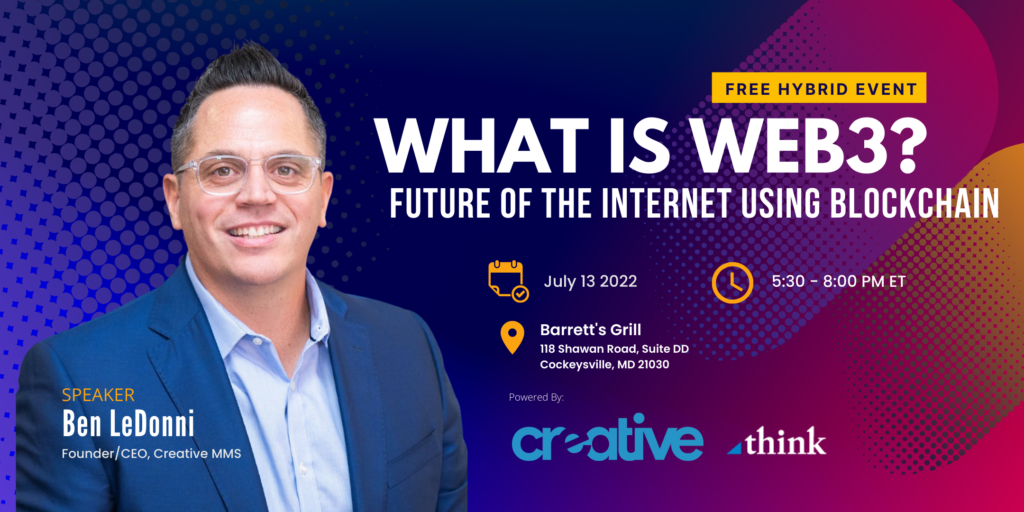Blockchain and NFTs’ Impact on Business in 2022

Blockchain. NFTs. Crypto. Web3. No discussion of the current state of affairs in technology is complete without those terms, but what do they really mean for business in 2022 and beyond?
That was among the questions addressed in a roundtable meeting of BaltoMSDN, chaired by Think CIO/VP Ed Mullin and hosted at the offices of Whiteford|Taylor|Preston in Baltimore. More than a dozen professionals in spaces ranging from software development to intellectual property law chimed in on the present and the future of blockchain and related technologies.
While these are abstract concepts for many in the greater business world, the BaltoMSDN gathering brought a great deal of hands-on experience and enthusiasm to the discussion. As one participant said, “If we didn’t talk about this here, I’d talk about it with myself and my dog.” Another attendee noted that she has been involved in the metaverse since well before it had that name, designing interactive medical training for overseas participants as far back as 2008.
Ed Mullin set the tone by noting that any predictions of the future are likely to be incomplete, as progress in technology tends to take unexpected turns. A prime example of this, Ed noted, is the fact that Tim Berners-Lee, who essentially invented the internet, intended it as a fairly simple two-way collaboration tool.
Early discussion centered on the uncharted waters of intellectual property law as it relates to NFTs. One local vendor has managed to create fully animated versions of statues from the Louvre in Paris. Aside from the gee-whiz factor of a statue coming to life and walking around the room, the greater question is: Exactly who owns the rights to that work? How this plays out will obviously have huge financial ramifications.
Is blockchain the future or the present? Another panelist who works in tracking and distribution for the music industry pointed out that NFTs, which he described as a sort of safe deposit box for artists, are already having a significant impact there. Looking to the future, though, a software development attendee suggested that the goal of these new technologies is not to overthrow the establishment but to make incremental improvements, and he further pointed out the importance of timing in any new venture. Pets.com is widely ridiculed as a failed example in the first incarnation of the web, but Chewy.com has been extremely successful with essentially the same model.
“Don’t mistake a short view for a clear distance,” said another panelist, noting that despite the speed of technological change, many larger developments have taken much longer than expected to happen. “Two more years” is the running joke in the industry.
Predictably, the discussion turned to cybersecurity and its corollary, the absence of any controlling entity for this technology. In the latter case, that lack of a guiding authority is not always a bad thing. Ed noted the example of blockchain being used to pay soldiers in Africa, bypassing banks and government and the inherent corruption and skimming from traditional pay methods.
An IP attorney brought up a recent GAO report, and another commissioned by DARPA, both of which highlight cybersecurity concerns. By design, the way data is processed makes it visible to others, and even when it’s encrypted there are points of vulnerability as it moves from one server to another. Another participant countered that blockchain is designed for transparency and not security, which raises the question: “Whose security are we talking about?” A security expert noted that in practice, most security issues have occurred at the ‘gate’ end of a transaction (in the case of cryptocurrency, the wallet).
The other side of that coin, though, is that NFTs are also being used to combat security concerns. A panelist shared that a major medical supplier uses NFTs to track resale of its products worldwide in an effort to combat pirating, counterfeiting and the sale of defective equipment on the black market and elsewhere.
In the absence of a controlling authority, though, security and enforcement for blockchain and Web3 will ultimately be up to consumers.
On the topic of Web3, we look forward to learning more at our in-person and virtual event, “What is Web3?” on Wednesday, July 13th. Ben LeDonni, Founder/CEO of Creative MMS, will be our speaker on the future of the internet using blockchain. Ben will cover blockchain, wallets and NFTs, how they’ll change the web, which industries are likely to feel the biggest impact, and much more. Additional details and registration here.
